On View
Richard Mosse’s New Film Portrays the Refugee Crisis in Thermal Detail
It is set to premiere at London's Barbican Centre.
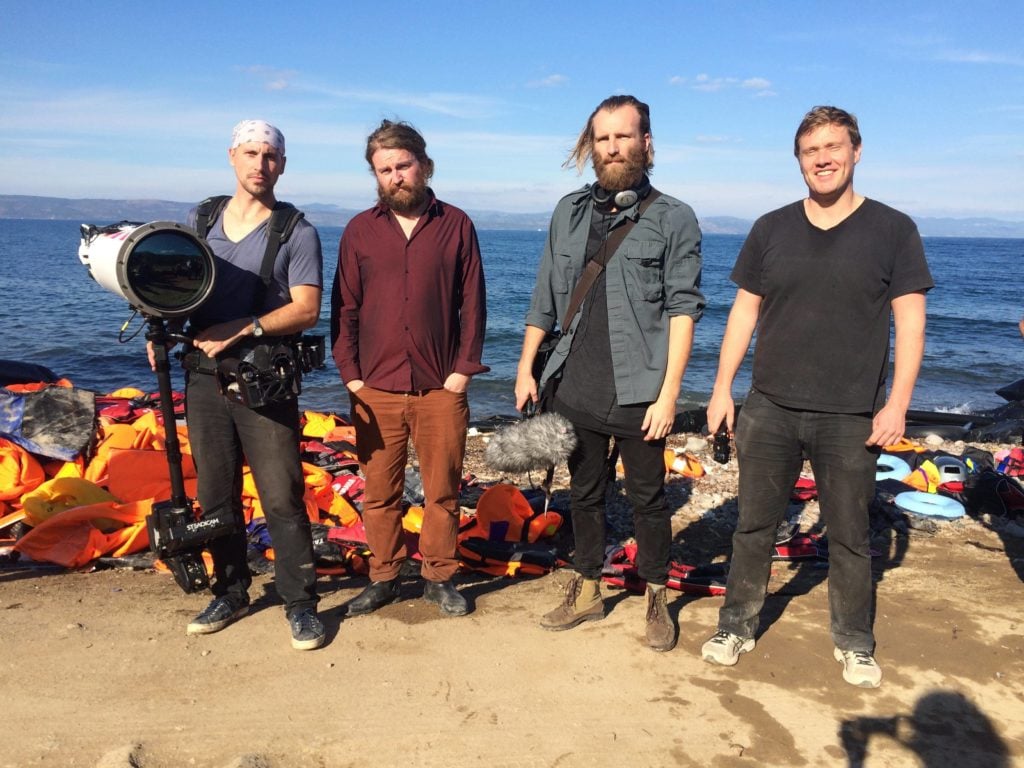
It is set to premiere at London's Barbican Centre.

Christian Viveros-Fauné

On October 28, 2015 award-winning Irish photographer Richard Mosse and his collaborators—cinematographer Trevor Tweeten, writer John Holten and composer Ben Frost—used an unlikely instrument to film a harrowing scene. Deploying a thermal imaging camera developed for the US military, they captured a human trafficker’s boat carrying 300 refugees as it sank into the waters off the coast of Turkey.
As the boat broke apart, they watched helplessly while human beings struggled against the waves before slipping silently into the sea. Too far away to lend a hand, they carried on filming from the Greek island of Lesbos, about six miles away.
“We literally watched as people got swept out in the tide,” Mosse recalled inside his cavernous studio in Ridgewood, Queens, where he screened his new three-channel, 52-minute film Incoming, set to premiere on February 14 at London’s Barbican Centre.
“A Frontex (EU border and coast guard agency) boat with tons of shiny new gear got close, but they couldn’t save a sinner—it wasn’t designed for rescue. About 70 people drowned that day.”
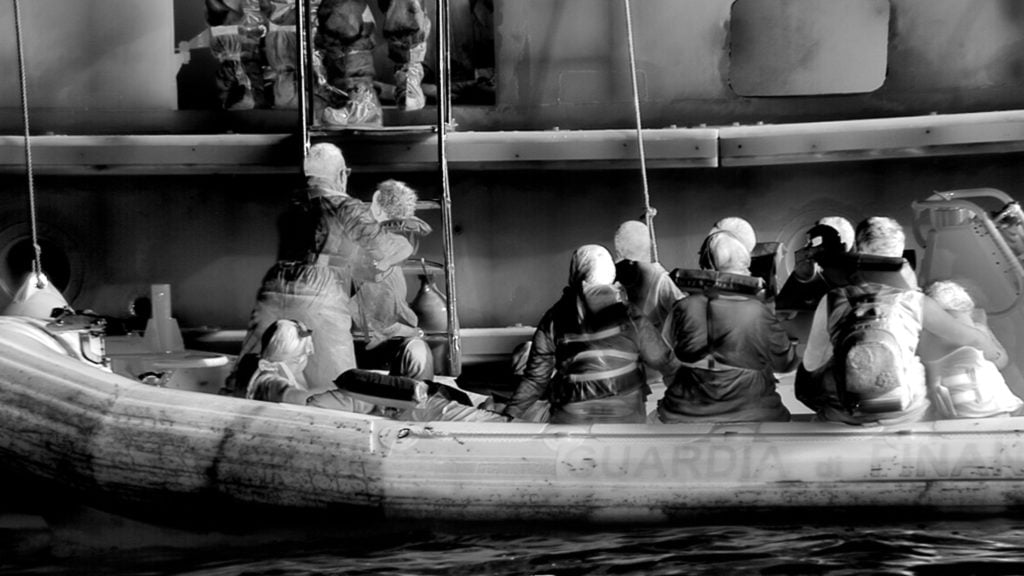
Still from Incoming, 2014-2017, by Richard Mosse in collaboration with Ben Frost and Trevor Tweeten, co-commissioned by the National Gallery of Victoria, Melbourne, and Barbican Art Gallery, London. Courtesy of Richard Mosse and Jack Shainman Gallery.
At a time when the world is experiencing the largest human migration since World War II, with more than a million people fleeing to Europe in 2015 by sea—escaping the war in Syria, political persecution in Africa and the Middle East, and climate change and poverty nearly everywhere else—Mosse resolved to document this terrifying human ordeal through a set of dramatic still and moving images. Fittingly, he did so using a camera that is sanctioned as a weapon by international law because of its unique ability to see at distances of 18-plus miles.
“What better way to certify the human costs of war than with a weapon designed for targeting and border control?,” Mosse said as we watched his film unfold across three 12-foot screens.
Besides debuting his new film in London this month, Mosse unveiled eight new photographs at Jack Shainman Gallery in New York last week. A hefty new book of images featuring essays by Mosse and the philosopher Giorgio Agamben is due out soon—courtesy of the renowned publishing house MACK.
A third venue to currently host Mosse’s work is the Bowery’s International Center of Photography. Their aptly titled group show, “Perpetual revolution: the Image and Social Change,” features a single still image among dozens of chattering AVIs and MPEGs: Mosse portrays a group of refugees radiantly haloed in alabaster light inside the charcoal darkness of the Indomeni refugee camp in Greece.
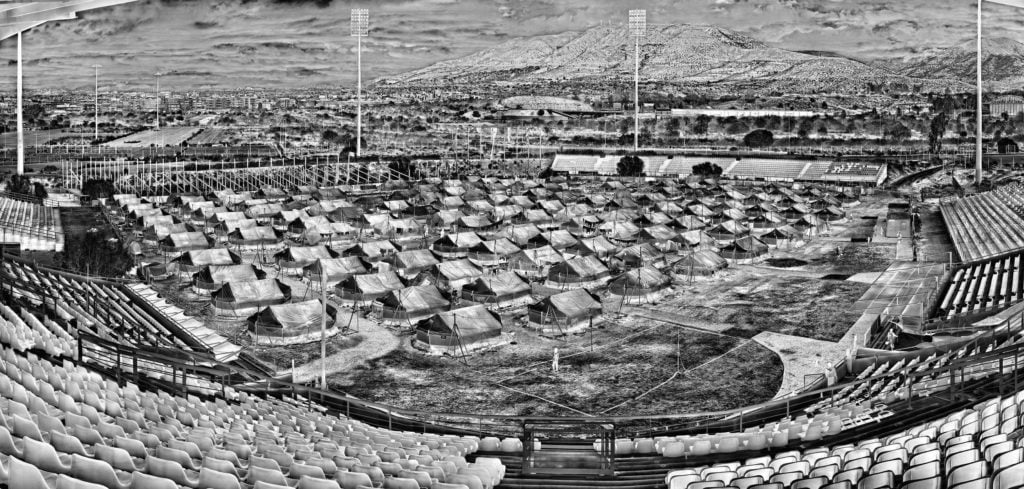
Hellinikon Olympic Arena, Athens, 2016. Courtesy of Richard Mosse and Jack Shainman Gallery.
Shot with a thermographic camera Mosse sourced from a European weapons manufacturer that also makes drones and missiles, the artist’s moving and still images reveal the awkward deal the artist has struck between himself and his chosen technology. “The camera is color blind,” Mosse explained as we considered the real-life choreography of his computer-generated images. Among other jarring footage, the film features monochrome silhouettes of US navy personnel servicing fighter jets on the carrier U.S.S. Theodore Roosevelt, shots of actual human rescues taking place on the choppy Aegean Sea and repeated captures of groups of colorless, ambling, wraith-like refugees.
“The camera basically dehumanizes its subjects and makes them look like zombies by reducing them to their basic biological essence, their heat signature. Among other things, it reads people’s eyes as orbs of viscous black jelly, which makes a mockery of the idea of the eyes being a window to the soul. It really is a deeply sinister technology.”
Besides dealing with the ethical components of his particular medium, Mosse realized soon after launching his project that his large and unwieldy camera required the development of a set of new artistic routines. For starters, the camera’s heft demanded that it be mounted onto a steadycam rig, 180 pounds of which Tweeten harnessed and bodied for days on end. Also, since the machine was originally designed for use with a keyboard, Mosse adapted an XBox controller to hand-tune functions that would normally be conducted digitally.
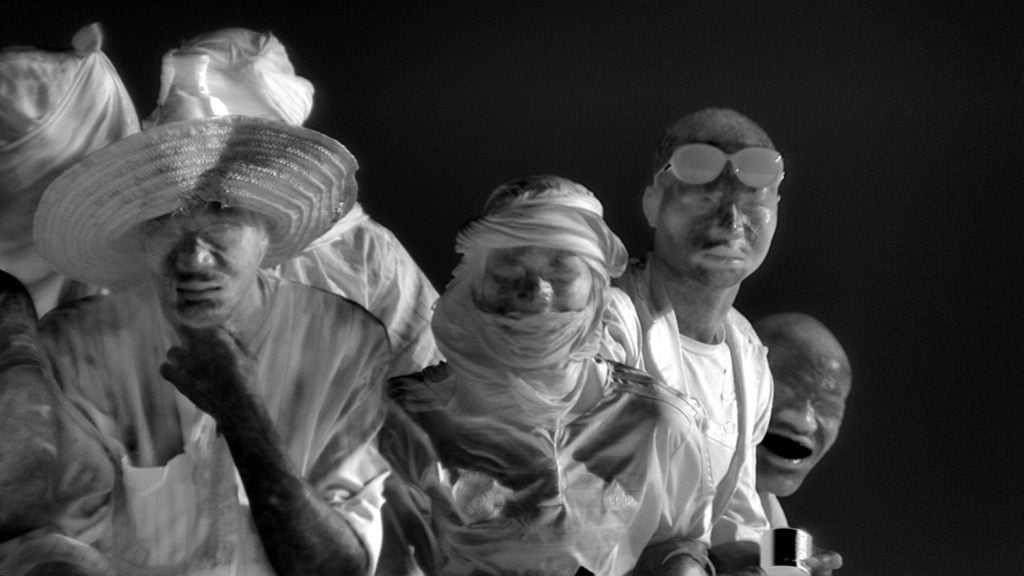
Still frame from ‘Incoming’, three-channel video installation with 7.1 surround sound, 52 mins 10 secs, by Richard Mosse, 2016-17. Co-commissioned by the Barbican Art Gallery, London, and National Gallery of Victoria, Melbourne. Courtesy of the artist, Jack Shainman Gallery, New York, and carlier | gebauer, Berlin.
The result was an awkward dance between the two collaborators, with Tweeten leading and Mosse following close behind in search of the perfect moment. Here’s a mental image that comes to mind in considering the collaborators’ gawky pas de deux: Leonardo and his longtime associate Salaì running a three-legged race while trying to draw the Mona Lisa with an etch-a-sketch.
Another aspect of the hair-raising nature of Mosse’s two-year project is captured by a McGuyver-like story Tweeten relayed inside the studio. During one of the many instances when the camera broke down and endangered the project’s multi-person, multi-trip mission, he enlisted a Greek car mechanic to open, repair and solder the machine together. The tale doesn’t sound so remarkable, until one considers that the camera in question costs about the same as a new sportscar.
Accompanied by Frost’s loudly dissonant soundtrack, Incoming is a fully immersive experience that tracks the different stages of the refugee crisis like a modern-day Biblical Exodus. It follows refugees migrating from the Middle East and North Africa into Europe through two different routes: by boat from Turkey to Greece and overland through the Sahara to Libya and then to Italy.
The film documents people living in several refugee camps, including the former Tempelhof Airport in Berlin and the recently shuttered “Jungle” in Calais. Mosse’s footage also includes images of an actual cannon battle in Syria, in which US aircraft strafe Isis positions; as well as a scene featuring dozens of refugees piled up Mad Max-style atop a vehicle as it barrels along a stretch of desert in the Al Qaeda-controlled area of the Maghreb.
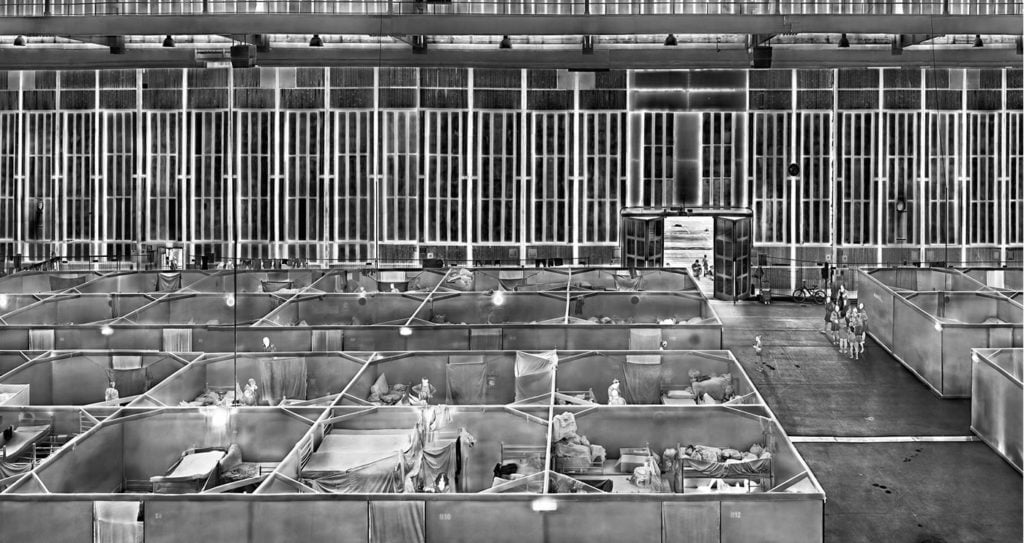
Still frame from ‘Incoming’, three-channel video installation with 7.1 surround sound, 52 mins 10 secs, by Richard Mosse, 2016-17. Co-commissioned by the Barbican Art Gallery, London, and National Gallery of Victoria, Melbourne. Courtesy of the artist, Jack Shainman Gallery, New York, and carlier|gebauer, Berlin.
The entire project makes for remarkably poetic and often shocking viewing—one scene depicts an autopsy conducted to identify the corpse of an anonymous refugee—of the sort that marries naturally occurring Busby Berkeley productions, like disasters and mass migrations, with the fearsome idea of military surveillance. No wonder Mosse, in his essay in the forthcoming MACK book, compares the refugees’ trials to those in Homer’s Odyssey.
As Mosse writes, “migration is as old as humanity,” by which he means that it’s enduring, ancient, mythic and woven into the very fabric of human history. His film and photographs bear witness to man’s abiding flight impulse turned into the great humanitarian crisis of our time in spectacular, haunting, and glowing black and white.